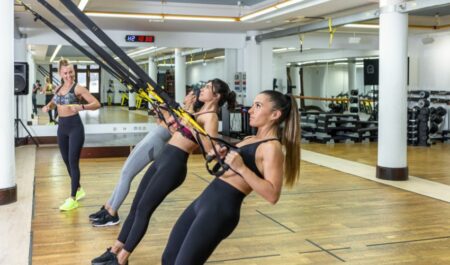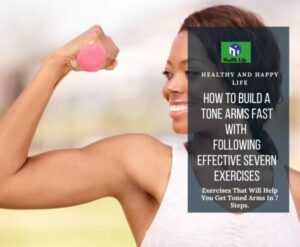We are unable to “spot reduce” fat in certain areas of our bodies, despite the fact that we may wish it were possible. According to research, exercises and devices that claim to get rid of love handles or to slim down your thighs are not effective at doing either of those things.
Exercises that focus on one specific area of the body at a time are not effective for reducing fat in localized areas of the body.
However, this does not mean that you will not be able to reduce the amount of fat in both your arms and the rest of your body by performing these workouts.
The American Council on Exercise recommends that in order to successfully reduce body fat, an individual should engage in cardiovascular exercise, strength training, and maintain a nutritious diet. You will be able to raise your heart rate, strengthen your arms, and minimize the amount of body fat you have by performing these exercises.

1. Arm Slip.
Arm slides are excellent for working your arms, particularly your triceps, and they also train your core in a comprehensive manner. Core exercises like as arm slides, which are recommended by the Mayo Clinic, can reportedly help improve a person’s general balance, stability, and body alignment.
Sliders, paper plates, or two little towels are the necessary pieces of equipment.
How To Do?
- Get down on your knees and place both hands on the sliders. If you have knees that are easily irritated or if you are doing this activity on a surface that is not soft, placing a pad under your knees will make it more bearable.
- To activate your core, bring your belly button in toward your spine while simultaneously contracting your abdominal muscles.
- Moving your arms slowly in front of you while keeping your spine in a neutral position and your abdominal muscles engaged will bring your chest closer to the floor.
- Return to the starting posture without bending your elbows by bringing your arms back in toward your knees and pulling them back out again. As you bring your arms closer to your body, you want to make sure not to arch your back. Be sure to concentrate your focus throughout the movement on keeping your core engaged and maintaining a straight back position.
Tips.
- You can make this process easier on yourself by sliding each arm separately.
- Additionally, you are able to obtain all of the benefits without having to touch your chest to the ground. Just get as low as you can while stopping before the following:
- It is no longer possible for you to pull your hands back in while maintaining a straight spine.
- ahead of your chest making contact with the ground.
- You can increase the difficulty of the workout by lowering your arms from a plank position and keeping your knees off the ground during the entire movement.
2. Ball Slams.

You get all of the benefits of this plyometric activity without having to subject yourself to the hammering. Your arms will get tired from doing ball slams, which are a full-body workouts that also incorporates some cardio into your workout.
Medicine ball or slam ball is required as a piece of equipment.
How To Do?
- Maintain a stance with your feet slightly wider than hip-width apart and the ball held close to your chest.
- Raise the ball above your head and tilt it slightly behind your ear.
- Make sure your knees are bent and then aggressively try to toss the ball as hard as you can down on the ground.
- Bring the ball back up over your head by catching it as it bounces back up (or by scooping it up if it doesn’t bounce) in either case. Maintain a straight spine at all times and pull yourself up by bending and straightening your knees.
- Start the following iteration in your routine.
Tips.
- Before you get started, you should check to see that the ball doesn’t have an overly forceful bounce. The ball should be heavy enough to require some effort to move, but not so heavy that you cannot complete the movement while maintaining a straight back.
- This motion ought to be carried out in a fluid manner. When you have completed a set of repetitions, immediately use the tiny bounce of the ball to propel you into the next set. You want to keep your heart rate up and the movements fluid, so do everything you can to keep moving while you’re doing these repetitions.
- Start with three to five sets of as many repetitions as you can complete in twenty to thirty seconds. Make sure that you give yourself enough time to rest in between each set.
- When you reach the point where you are unable to properly hold the ball over your head or keep your spine straight throughout the movement, you should stop the exercise.
It is important to remember to give your arms a break from intensive or high-impact plyometrics until you have fully recovered from your plyometric workout, as the National Strength and Conditioning Association suggests taking 48 hours to recuperate following a plyometric workout.
3. The Dumbbells Bench Press
To reap the benefits of doing bench presses, it is not necessary to use particularly heavy weights.
Your muscles will be put to the test when you perform a dumbbell bench press, and this will assist minimize any muscle imbalances or weaknesses between your dominant and nondominant arms. The dumbbell bench press is primarily used for exercising the chest, although it also strengthens the deltoids, triceps, and lats. It is the most well-known chest exercise.
A pair of dumbbells and a bench are required pieces of equipment.
How To Do?
- Lay down on the bench so that your back is supported by it and your feet are firmly planted on the ground. If your feet are not firmly touching the ground, you can either put plates or a step bench under them to give you a secure position, or you can put your feet up on the bench to give yourself a sturdy position.
- By activating your core, you can ensure that your spine is in a neutral position (your lower back should be slightly curved).
- To improve your posture, move your shoulder blades away from your ears and bring them together just a little bit. Your head, shoulders, and hips should all be in close contact with the bench while you sit there.
- As you bring the dumbbells to your shoulders, make sure to keep your arms close to your sides. Throughout the entirety of the action, the palms of your hands should be facing forward or at a 45-degree angle.
- Bring the dumbbells up to your chest while keeping your elbows at your sides as you slowly descend them. To get the most out of your triceps workout, make sure to keep your elbows in close to your sides during the entire exercise.
Tips.
You can perform these exercises either on the floor or on a step bench if you do not have access to a traditional bench.
4. Banded Bicep Curls With A Weight.
The necessary piece of equipment is a resistance band.
How to Do?
- Put your weight on the band so that it is positioned directly beneath the arch of your foot.
- Take hold of both ends of the band with your palms facing forward and your arms resting at your sides.
- Bring your hands up to your shoulders while keeping your elbows pressed against your ribs. Bend your arms slowly while you do this.
- Bring your hands back down to your sides in a slow and steady motion.
Tips.
You shouldn’t swing your arms or lean back to raise your hands. Your arms are the only parts of your body that should move. Your body should remain perfectly erect and still.
5. Supine Barbell Rows Or TRX.

By performing this exercise, not only will you be working your arms, but you will also be strengthening the muscles in your upper back that are responsible for improving your posture.
TRX straps, low gymnastics rings, or a barbell and a rack are necessary pieces of equipment for this exercise.
How To Do?
- Grab the handles, and while walking backwards slowly, pull the handles apart to create stress in the straps.
- Walk your feet toward the anchor point of the straps until you are at a 45-degree angle, keeping your chest turned to face the anchor point of the straps. Keep your palms facing forward while you hold the straps.
- As you begin to raise your chest up to the handles, you should engage your core in the same way that you would if you were in a plank position and keep your body in a straight line. Maintain a neutral spine by keeping your shoulder blades down, away from your ears, and slightly pressed together.
- As soon as your hands and chest are in contact, return to the starting position by carefully lowering yourself down until your entire body is in a vertical line.
Tips.
- Experiment with your hold on the object. Triceps will get a workout if you turn your palms down toward your feet. Exercise your biceps by turning your palms so that they face your head.
- Stand more erect by moving your feet closer to the anchor point. This will make the rows easier to perform. You want to be standing in such an upright position that you are able to retain both your hips and back in a straight line for the entirety of the exercise, without bending or arching your spine.
- If you desire a more difficult task, move your feet further away from your hands than they are already.
- If you do not have TRX straps or rings, you can perform the exercise using a rack and an empty barbell. Take care to position your head such that you are drawing the bar back into the rack rather than toward the front of the hooks. This will ensure that you do not injure yourself. The height of the bar can be adjusted to make it easier (up) or harder (down) to climb (down).
6. Perform A Narrow Pushup.
Equipment needed: None.
How To Do?
- Put your hands in a plank posture directly under your shoulders with your fingers pointing forward. Hold this position for 30 seconds.
- Bring your elbows to your sides so that they are pointed toward your feet as you squat down. As you bring your chest closer to the floor, be sure that your shoulders, hips, and knees remain in a perfectly straight line.
- You should not arch your lower back as you try to push yourself back up to the starting position. It is important to lift your shoulders at the same moment as your hips.
Tips.
You can perform these exercises on your knees to make them more manageable, or you can use weight plates or a step bench to elevate your hands.
7. Ropes For Use In Combat.
Utilizing these ropes will allow you to burn fat, improve your cardiovascular endurance, and tone your arms all at the same time. In addition to elevating your heart rate and causing you to break a sweat, these exercises will also help you build strength in your shoulders and core.
Ropes for combat are a necessary piece of equipment.
How To Do?
- Maintain a straight back, knees that are slightly bent, and hip-width distance between your feet.
- Take hold of the ropes and bring your hands together in front of you to make a wave.
- You can produce smaller waves by increasing the speed at which you move your hands, or you can generate larger waves by decreasing the pace at which you move your hands and moving them a greater distance.
- You should strive to maintain the ropes moving for a total of three intervals of thirty seconds each, with rest periods in between each set.
Tips.
- Experiment with making small waves, long waves, moving both arms at the same time, alternating moving one arm up and one arm down, and moving both arms in and out, in addition to moving them up and down.
- You might also try to slam the ropes into the ground much like you did with the ball earlier.
The Takeaway
You will notice a difference in the strength and tone of your arms after performing these workouts. They won’t help you get rid of the fat on your arms, but they will help you lose weight all over your body and display the muscles you’ve worked so hard to build.
FAQs
According to Kawamoto, the answer is that the time it takes for your muscles to get ripped can range anywhere from four to eight weeks, depending on how frequently you exercise and the intensity of your workouts.
Yes, says Janey Holliday. However, you can’t simply focus on your biceps; you need to exercise all of your muscle groups. “The triceps (at the rear of the arm) are particularly under-conditioned, as we tend not to use them much day-to-day,” she explains. “This is because we don’t tend to use the back of our arms very much.” When you train muscles that are weaker, they adapt more rapidly, and you can begin to notice improvements in as little as two weeks.
Therefore, how frequently should you exercise your arms in order to achieve the maximum amount of muscular growth? Arm exercises can be performed anywhere from twice to six times per week. The more often you train your arms, the fewer sets you should perform in a single day. If you train your arms twice a week, you will perform two to three exercises during each session for a total of three to four sets.
